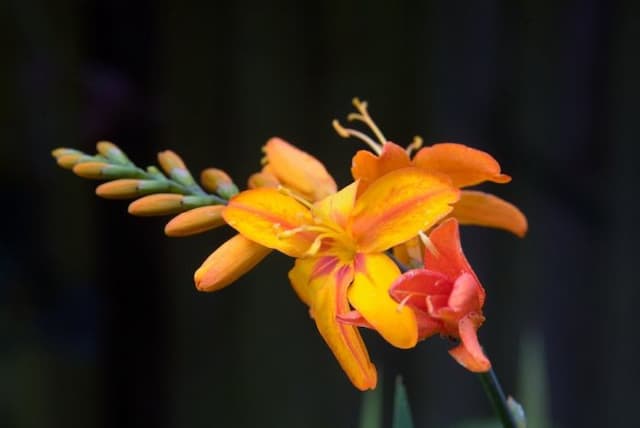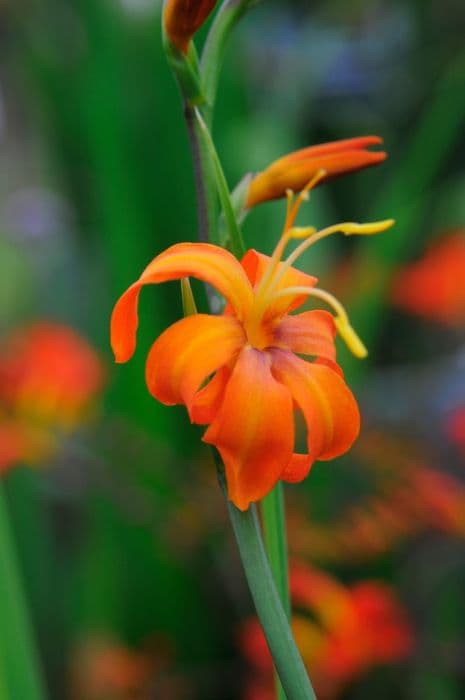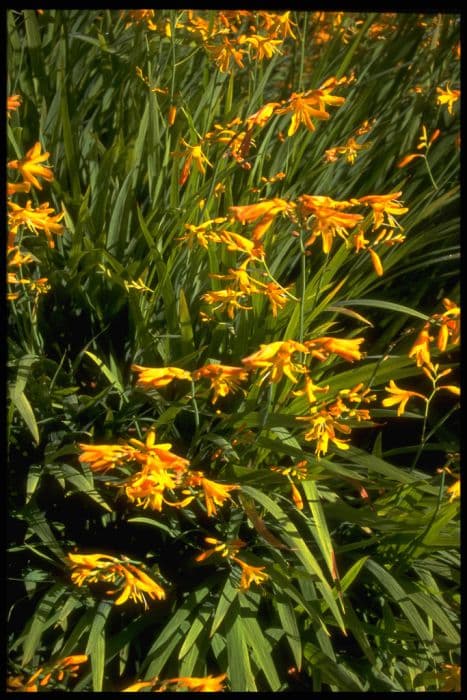Croatian crocus Crocus malyi 'Sveti Roc'

ABOUT
The Crocus malyi 'Sveti Roc' is a perennial plant known for its striking bloom which emerges in early spring. The flower is characterized by its cup-shaped, vibrant petals, which can vary in color from violet to lilac, with a lighter throat and often darker vein-like markings which add to the visual appeal. Each blossom has a delicate and yet striking appearance, with a bright orange stigma that stands out against the petals, contributing to its ornamental value. The leaves are narrow and grass-like, typically exhibiting a dark green color with a silvery stripe running along the midrib, adding further contrast to the colorful flowers. When in bloom, the plant carries an aura of freshness and renewal, often seen poking through the last remnants of snow or the early spring soil, heralding the change of seasons.
About this plant
 Names
NamesFamily
Iridaceae
Synonyms
Sveti Roc Crocus, Mali Crocus
Common names
Crocus malyi 'Sveti Roc'.
 Toxicity
ToxicityTo humans
Crocus malyi 'Sveti Roc', commonly known as Crocus, is not widely recognized for being toxic to humans. Generally, crocus plants from the Iridaceae family, especially the autumn-blooming species, can contain colchicine, which is a poisonous alkaloid. However, the toxicity can vary significantly between species and the specific parts of the plant. Ingesting large quantities of the crocus' corms might lead to symptoms such as nausea, vomiting, diarrhea, abdominal pain, and more severe cases can result in liver and kidney impairment, respiratory failure, seizures, and even death due to cardiovascular collapse, but there is little information available about the toxicity of this specific subspecies to humans. It's therefore advised to exercise caution and avoid ingesting any part of unknown crocus plants.
To pets
Crocus malyi 'Sveti Roc', commonly referred to as Crocus, is not commonly known to be toxic to pets. However, it's important to distinguish between Crocus species, as some, like the autumn crocus (Colchicum autumnale), can be highly toxic. They contain colchicine, which is dangerous for both humans and animals. If a pet were to ingest a plant containing colchicine, it could exhibit symptoms like gastrointestinal upset, including vomiting, diarrhea, drooling; more severe effects include organ failure, seizures, and potentially death. Since specific toxicity data for Crocus malyi 'Sveti Roc' isn't widely available, it is prudent to err on the side of caution and prevent pets from ingesting this or any unidentified crocus plant.
 Characteristics
CharacteristicsLife cycle
Perennials
Foliage type
Deciduous
Color of leaves
Green
Flower color
Lilac
Height
4 inches (10 cm)
Spread
3 inches (7.5 cm)
Plant type
Bulb
Hardiness zones
5
Native area
Balkans
Benefits
 General Benefits
General Benefits- Ornamental Value: Crocus malyi 'Sveti Roc' adds aesthetic appeal to gardens with its vibrant flowers that bloom in early spring.
- Ease of Care: The plant is relatively low maintenance, requiring minimal care once established in the right conditions.
- Attracts Pollinators: The flowers attract bees and other pollinators, which are crucial for the health of gardens and the ecosystem.
- Early Bloom: As one of the first flowers to bloom in spring, it can provide color in the garden when most other plants are still dormant.
- Drought Tolerance: Once established, it is quite tolerant to drought, making it suitable for xeriscaping and water-efficient gardens.
- Compact Growth: Its small size and compact growth habit make it ideal for borders, rock gardens, and small spaces.
- Naturalizing: Crocus malyi 'Sveti Roc' can naturalize and multiply over time, creating larger displays each year.
 Medical Properties
Medical PropertiesThis plant is not used for medical purposes.
 Air-purifying Qualities
Air-purifying QualitiesThis plant is not specifically known for air purifying qualities.
 Other Uses
Other Uses- The corms of Crocus can be used as a natural water indicator, swelling in the presence of moisture, which could help in monitoring the watering needs of other nearby plants.
- In art, the vibrant colors of Crocus flowers can be used as a natural dye for fabrics, providing a sustainable alternative to synthetic dyes.
- The petals of the Crocus can be used in crafting activities, such as making bookmarks, greeting cards, or potpourri, due to their delicate form and color.
- Crocus flowers can also serve as a muse for photography enthusiasts, offering a unique opportunity to capture the early signs of spring and the insects they attract.
- Gardeners sometimes use dried Crocus petals as a decorative mulch to add color to potted plants or garden beds.
- The flowers of the Crocus can be used in culinary presentations, as an eye-catching, edible garnish on salads and desserts, owing to their safe, non-toxic nature.
- In educational settings, Crocus can be incorporated into botanical studies and biology curricula to illustrate plant life cycles and pollination processes.
- The stigma of the Crocus flower, specifically in Crocus sativus, is harvested as saffron, which can be used as a natural coloring and flavoring in dishes.
- Crocus flowers can act as living thermometers; their opening and closing can indicate temperature changes to gardeners.
- Collectors of rare and ornamental plants often seek out varieties like Crocus 'Sveti Roc' for adding to specialized garden collections that showcase biodiversity.
Interesting Facts
 Feng Shui
Feng ShuiThe Crocus is not used in Feng Shui practice.
 Zodiac Sign Compitability
Zodiac Sign CompitabilityThe Crocus is not used in astrology practice.
 Plant Symbolism
Plant Symbolism- Hope: The Crocus typically blooms in early spring, symbolizing the end of winter and the arrival of warmer days ahead, representing new beginnings and hope.
- Youthfulness: Due to its early bloom, often when snow is still on the ground, the Crocus is associated with youthfulness and cheerfulness, pointing to the vibrancy of new life.
- Joy: With its bright and cheerful colors, the Crocus is commonly associated with joy and happiness as it brings the first sign of spring after the long winter months.
- Gladness: In the language of flowers, the Crocus conveys gladness, possibly because it signals the impending arrival of spring and the earth's reawakening.
- Purification: In some cultures, the Crocus is a symbol of purification, as it is one of the first flowers to emerge, clearing the way for the rest of springtime's bounty.
 Water
WaterThe Crocus malyi 'Sveti Roc', commonly known as Illyrian crocus, needs to be watered deeply but infrequently, as they prefer well-drained soil and are relatively drought tolerant once established. During the active growing season in fall and early spring, water when the top inch of soil feels dry, which may equate to about one to two gallons every 7-10 days, depending on climate conditions. Reduce watering after the blooming period as the plant enters a dormant phase in late spring and summer. Overwatering can cause bulb rot, so ensure the soil is not waterlogged by allowing it to dry between waterings.
 Light
LightIllyrian crocus thrives in full sunlight to partial shade. The ideal location would be a spot that gets direct morning light and some shade during the hottest part of the afternoon, aiding in the best growth and flower production. They can also tolerate full sun as long as they are not exposed to excessively hot temperatures, which could damage the delicate flowers.
 Temperature
TemperatureThe Illyrian crocus does best in a temperature range that mimics its native habitats. It can survive winter temperatures down to about 20°F and is comfortable during the flowering period at temperatures between 50°F and 70°F. During the active growth and bloom period, maintaining a daytime temperature around 60°F to 65°F will promote optimal growth and flowering.
 Pruning
PruningIllyrian crocus generally requires minimal pruning. After flowers fade, remove only the spent flower stems, leaving the foliage to die back naturally. This helps the plant to gather energy for the next growing season. The best time for any pruning or cleanup is when the leaves have yellowed and withered, which is typically by late spring or early summer.
 Cleaning
CleaningAs needed
 Soil
SoilCrocus, commonly known as Crocus malyi 'Sveti Roc', thrives best in a well-draining soil mix composed of equal parts potting soil, sharp sand, and peat or compost. The optimal soil pH for this crocus should range from slightly acidic to neutral, around 6.0 to 7.0.
 Repotting
RepottingCrocus malyi 'Sveti Roc', also known as Crocus, should be repotted every 2 to 3 years to ensure the soil is nutrient-rich and to refresh the potting mix.
 Humidity & Misting
Humidity & MistingCrocus, or Crocus malyi 'Sveti Roc', prefers moderate ambient humidity levels but is generally tolerant of a wide range as long as it is not excessively high or low.
 Suitable locations
Suitable locationsIndoor
Place Crocus malyi 'Sveti Roc' in bright indirect light inside.
Outdoor
Crocus malyi 'Sveti Roc' needs well-drained soil and partial sun.
Hardiness zone
3-8 USDA
 Life cycle
Life cycleThe Crocus malyi 'Sveti Roc', commonly known as Sveti Roc Crocus, begins its life cycle when a corm, an underground storage organ, is planted in well-drained soil in late summer or early fall. After planting, roots develop from the base of the corm, and foliage emerges along with colorful flowers, typically in early spring. The plant blooms, producing violet to lilac flowers with golden throats that are pollinated by insects, leading to seed formation. Once flowering is complete, the foliage continues to photosynthesize, replenishing the corm until the leaves die back in late spring or early summer. The plant then enters a dormant phase during the hot summer months, where the corm remains underground. In the next growing season, the cycle begins anew with the existing corm forming new flowers and possibly producing offsets (baby corms) for propagation.
 Propogation
PropogationPropogation time
Spring
The Crocus malyi 'Sveti Roc', commonly known as Sveti Roc Crocus, is typically propagated through division, which is the separation of bulb clusters. The most favorable time for this method is in the summer, after the foliage has died down, indicating that the plant is dormant. To propagate Sveti Roc Crocus by division, carefully dig around the clump of bulbs and lift them out of the soil. Gently pull apart the bulbs, being sure to keep a generous amount of roots attached to each one. Once separated, replant the individual bulbs at a depth of approximately 3 inches (approximately 7.6 centimeters) in well-draining soil, spacing them about 3 to 4 inches apart (approximately 7.6 to 10.2 centimeters). This method allows for the plant to re-establish quickly and continue growing, often flowering the next season.
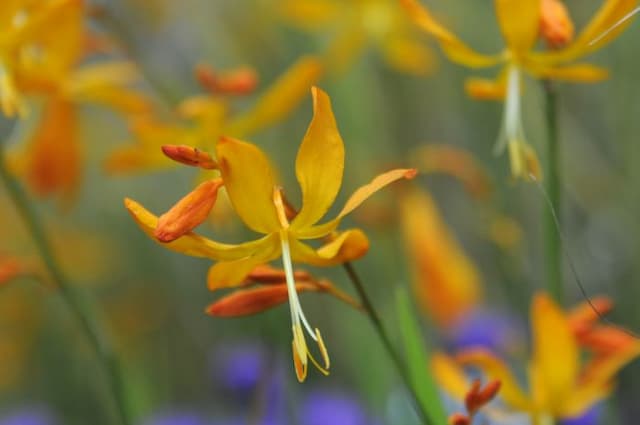
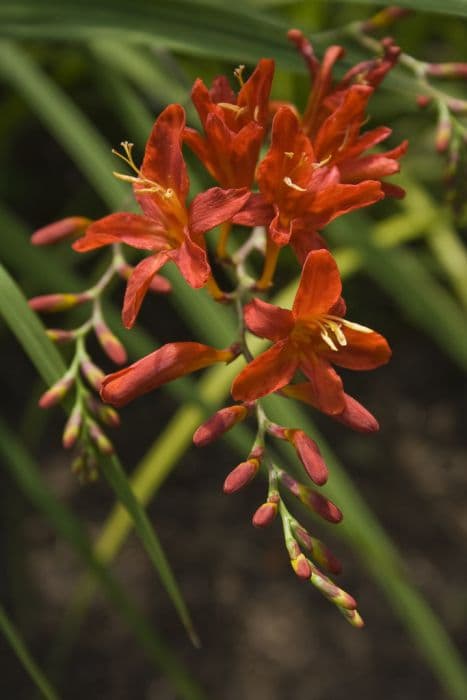
![Montbretia [Bright Eyes]](/_next/image?url=https%3A%2F%2Fplants-admin.emdemapps.com%2Fimages%2Fplants%2F%2Fimages%2F604b5f4a483b6.png&w=640&q=75)
